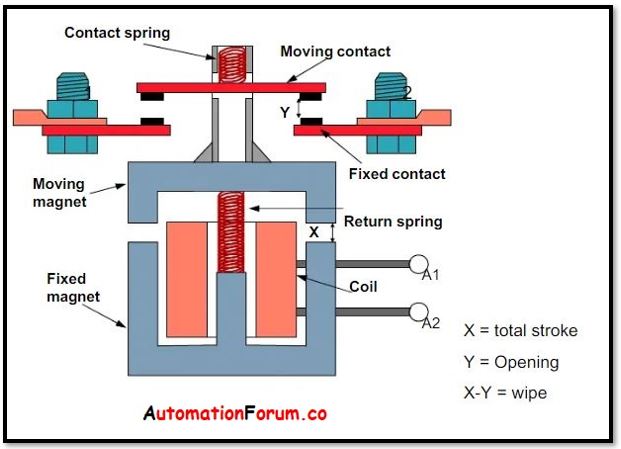Different types of time delay relays

Introduction
Time delay devices are used for delaying the start-up, shutdown, recycling, or continuation of processing operations
until the desirable requirements have been satisfied or the required conditions have been obtained.In this session we are gonna discuss about the different types of time delay relays
Dashpot or Pneumatic
In a “dashpot” type delay, the armature of a relay is increased by a piston that travels in an oil or fluid. The piston contains several holes through which the fluid passes. The current of the coil must be applied continuously to exert a pull on the armature. The armature travels slowly due to the resistance of the fluid, if it has the viscosity required to produce the necessary delay. The size of the opening holes can be modified to vary the time delay. Once the armature moves to the required distance, the movable contacts engage the stationary contacts. A dashpot
The delay time is shown in the figure. In a pneumatic time delay, the time it takes for a certain volume of air to pass through a pre-set opening size is used for timing. This design is made dustproof with a diaphragm and a lid, which cover the head in which the air is recirculated

Thermostatic relay
In this version of a time delay design, one of the contacts is a bimetallic element that is wrapped with an isolated heating coil. The signal strength is applied to the heating coil. The delay time is the time required to raise the contact temperature high enough to cause deformation, which will eventually cause the contact to transfer. The time tolerance (precision) of the standard thermostatic time delay relays is typically only ± 20% but with special designs
They are available with better tolerances. These units are also only repeatable at about ± 5%, but on the other hand, they are inexpensive and inherently resistant to transients. The figure shows a thermostatic time delay along with two forms of packaging.

Motor-Driven
This type of relay is powered by a synchronous motor. A firing arm is driven through a simple train of machine-cut straight gears. The arm activates a quick action switch, and the motor speed and reduction of the gear determine the delay time. The reset is instantaneous by means of an electromagnetic coil that clutches and disengages the trigger lock gear as needed. The clutch coil is often equipped with a set of auxiliary contacts.
The power supply is normally applied to the motor circuit, while the signal power is normally applied to the clutch
coil. In this way, there are instant contacts operated by the clutch coil and timed contacts operated by the trip arm. When clutch power is maintained, the delay in power interruption increases. In other words, the relay accumulates as long as the power supply has applied to the motor until it is equal to the preset time in the time delay relay. The use of a synchronous motor guarantees a high precision and, with the appropriate gear, allows very long delays, which include up to hundreds of hours. Sometimes these The relays are provided with a progress pointer. The figure illustrates a motorized delay.

Analog Solid State
Analog time delays are based on the RC circuit, in which a capacitor is charged through a resistor until it reaches a certain voltage. When the predetermined voltage is reached, the electromechanical load-switching relay or a solid state the switching device turns on or off, depending on the function. This type of synchronization is much simpler, more reliable and less expensive than the mechanically complex synchronous motor-driven delay relay. However, there are some shortcomings, which include the fact that the time constant curve for the capacitor charge is exponential, which makes it difficult to set a potentiometer (the R variable) precisely. Another limitation is that the RC circuit is sensitive to variations in the supply voltage. In addition, the stability and repeat accuracy of this design are affected by variations in resistance due to temperature variations, and in addition the capacitor changes its value as it ages. Measures can be taken to compensate for or diminish these adverse effects of voltage or temperature variations, but these steps add to the cost of the analog time delay relay. An analog time delay is shown in the Figure

Digital Solid State
The digital method to create a time delay uses a frequency count or a division circuit. This approach, although more expensive than the RC analog circuit, provides better accuracy and repeatability and lends itself to the integration of medium or large scale (chip). In this type of circuit, the pulses of an oscillator or the frequency of the power line are applied to a counter or to a divider chain, which is preset to emit a pulse in a specific count. This output pulse turns on or off the load-switching electromechanical relay or solid-state switching device. The frequency of the power line, 50 or 60 Hz, is used due to its stability. The use of a higher frequency free-running oscillator provides finer time increments. To obtain maximum precision, a crystal-controlled oscillator is used, which provides absolute precision and repeatability, which can be adjusted to the fourth significant figure. This type of delay relay is usually supplied with a wheel switch or DIP switches to program the division counter. The figure shows a digital time delay
Software-Based Time Delays
The software-based delays use the digital method of generating delays. Internal clock pulses are accumulated in a memory register or in a counter, which subsequently transfers its count to a memory register. The program regularly compares the accumulated count with a preset value that is stored in another memory register. When the accumulated count equals or exceeds the preset value, the program branches to another set of instructions that require the delay for further logic sequence.
Some microprocessor-based devices have a modified digital method that corrects this problem. The actual count takes place in an integrated circuit, which creates an interrupt when it reaches the preset count. This interrupts the main software program immediately, and load switching can be executed without incurring additional time delay. A software-based delay is depicted in Figure







